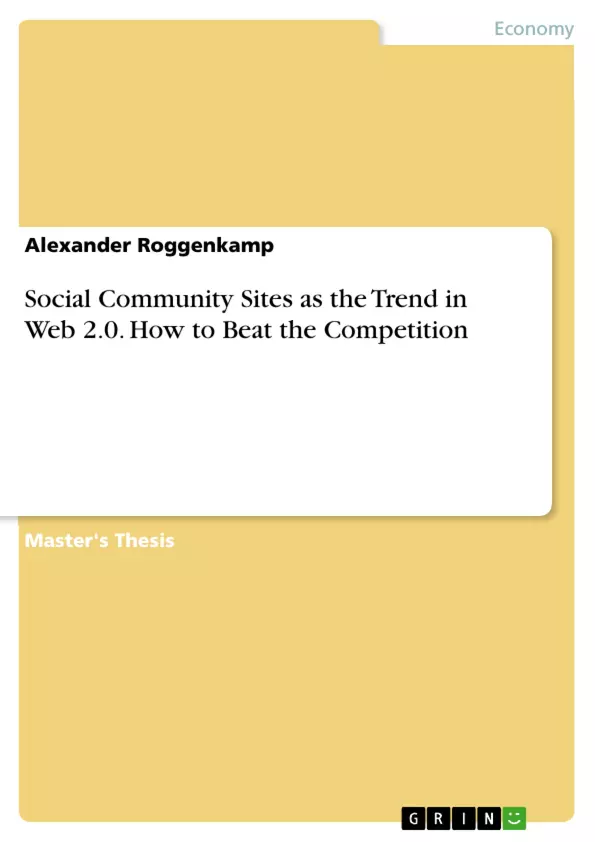Since a few years, many people talk about web 2.0 without knowing exactly what it is. It is not a new web standard, no new innovative product of Apple, no net movement or revolution. In fact, it is a paraphrase for the new active role of users.
The technological progress makes it possible that users participate in internet actively. Their role changed from a watching to a creating one. New tools and features enabled users to generate content. With other new websites, social community websites came up using these new possibilities.
By now, social communities like Facebook or studiVZ have millions of members. The huge acceptance on users’ side made those websites a real trend in web 2.0. The huge number of users makes social communities to an interesting business. Experts say that social communities are not only a trend, but also an important business in future. Although there are already some established companies acting on the market for social communities, the market will see a lot of new social communities in the next years.
There are only a few general social communities dividing up the market. And there are enough topics which are not occupied as yet. Only those social communities will beat the competition and will remain, which are able to generate revenue and profit.
Inhaltsverzeichnis (Table of Contents)
- Executive Summary
- 1. Introduction
- 1.1 Objectives
- 1.2 Methodology
- 2. What means Web 2.0?
- 2.1 Definition
- 2.2 Development
- 2.3 Internet Usage
- 2.4 Main Tools
- 2.4.1 User generated content
- 2.4.2 Blogs
- 2.4.3 Podcasting
- 2.4.4 Wikis
- 2.4.5 Tagging
- 2.4.6 RSS Feeds
- 2.4.7 Mashups
- 2.4.8 Social Bookmarking
- 2.4.9 Crowdsourcing
- 2.5 Effects
- 2.5.1 Social Effects
- 2.5.2 Economic Effects
- 2.5.3 Technological Effects
- 2.6 Problems
- 2.6.1 Copy Rights
- 2.6.2 Personal Rights
- 2.6.3 Data Protection
- 3. Social Community Sites
- 3.1 Social Interactions in General
- 3.1.1 What are Social Community Sites?
- 3.1.2 Social Contacts
- 3.1.3 Social Ties
- 3.1.4 Social Groups
- 3.1.5 Social Networks
- 3.2 Social Community offline
- 3.3 Social Community online
- 3.3.1 Average Members
- 3.3.2 Geographic Communities
- 3.3.3 Topic Communities
- 3.3.4 Demographic Communities
- 3.3.5 Business Communities
- 3.1 Social Interactions in General
- 4. How are Social Communities organised?
- 4.1 Community Purpose
- 4.2 Community Structure
- 4.2.1 User Profile
- 4.2.2 Member Contacts
- 4.2.3 New Contacts
- 4.2.4 Profile Quality
- 4.2.5 Attracting new Members
- 4.3 Social Interactions
- 4.4 User Participation
- 4.5 Connectivity
- 4.7 Chances and Risks for Providers
- 5. How is the Competitive Environment structured?
- 5.1 Competitors
- 5.2 Analysis
- 5.2.1 Environment
- 5.2.2 PEST-Analysis
- 5.2.3 Outcome
- 6. What are the Factors of Success?
- 6.1 Sectoral Factors
- 6.1.1 Market Entry and Level of Innovation
- 6.1.2 Space for Further Development
- 6.1.3 Maslow's Hierarchy of Needs
- 6.2 Company specific Factors
- 6.2.1 Number of Users
- 6.2.2 Objective and Vision
- 6.2.3 Participation and Activity
- 6.2.4 Content
- 6.2.5 Usability and Design
- 6.3 Technological Factors
- 6.3.1 User data base
- 6.3.2 Tracking and Reporting
- 6.1 Sectoral Factors
- 7. What are applicable Business Models?
- 7.1 Definition of a Business Model
- 7.2 Web-based Business Models
- 7.2.1 Overview
- 7.2.2 Effect of Web 2.0
- 7.2.3 Revenue Resources for Social Communities
- 8. Recommendations
- 8.1 Set clear Purposes and Objectives
- 8.2 Enable Growth and technical Development
- 8.3 Attract and Retain Members
- 8.4 Utilise several Revenue Resources
Zielsetzung und Themenschwerpunkte (Objectives and Key Themes)
This thesis aims to analyze the phenomenon of social community sites within the context of Web 2.0, focusing on their competitive landscape and factors contributing to success. It explores the characteristics of successful social communities and examines viable business models for these platforms.
- The definition and evolution of Web 2.0.
- The characteristics and structure of social community sites.
- Competitive analysis of the social community market.
- Key factors contributing to the success of social community sites.
- Applicable business models for social community platforms.
Zusammenfassung der Kapitel (Chapter Summaries)
The initial chapters define Web 2.0, detailing its development, key tools (blogs, wikis, etc.), and its impact. Subsequent chapters delve into the nature of social interactions online and offline, classifying different types of online communities (geographic, topic-based, etc.). The thesis then analyzes the organizational structure of social communities, focusing on aspects like user profiles, member interaction, and attracting new members. A competitive analysis follows, examining the competitive landscape and identifying key success factors for social communities.
Schlüsselwörter (Keywords)
Web 2.0, Social Community Sites, Online Communities, Competitive Analysis, Business Models, User Interaction, Success Factors, Revenue Generation.
- Quote paper
- Alexander Roggenkamp (Author), 2009, Social Community Sites as the Trend in Web 2.0. How to Beat the Competition, Munich, GRIN Verlag, https://www.grin.com/document/124393



